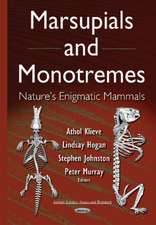Invertebrates in Hot and Cold Arid Environments: Adaptations of Desert Organisms
Autor Lauritz Sommeen Limba Engleză Paperback – 14 dec 2011
Terrestrial arthropods maintain their water balance through behavioural and physiological adaptations. Tardigrades and nematodes are remarkable in their ability to lose all their water, enter a state of anhydrobiosis and be revived when moisture becomes available again.
Din seria Adaptations of Desert Organisms
- 18%
 Preț: 954.14 lei
Preț: 954.14 lei - 18%
 Preț: 948.29 lei
Preț: 948.29 lei - 18%
 Preț: 945.92 lei
Preț: 945.92 lei - 18%
 Preț: 947.35 lei
Preț: 947.35 lei - 18%
 Preț: 1384.44 lei
Preț: 1384.44 lei - 18%
 Preț: 946.10 lei
Preț: 946.10 lei - 18%
 Preț: 1212.68 lei
Preț: 1212.68 lei - 18%
 Preț: 953.82 lei
Preț: 953.82 lei - 15%
 Preț: 632.70 lei
Preț: 632.70 lei - 15%
 Preț: 635.31 lei
Preț: 635.31 lei - 15%
 Preț: 639.25 lei
Preț: 639.25 lei - 15%
 Preț: 639.73 lei
Preț: 639.73 lei -
 Preț: 382.57 lei
Preț: 382.57 lei - 15%
 Preț: 636.80 lei
Preț: 636.80 lei - 15%
 Preț: 641.03 lei
Preț: 641.03 lei - 15%
 Preț: 636.45 lei
Preț: 636.45 lei - 15%
 Preț: 632.37 lei
Preț: 632.37 lei - 15%
 Preț: 637.28 lei
Preț: 637.28 lei -
 Preț: 378.92 lei
Preț: 378.92 lei - 15%
 Preț: 633.53 lei
Preț: 633.53 lei - 15%
 Preț: 693.71 lei
Preț: 693.71 lei - 15%
 Preț: 636.45 lei
Preț: 636.45 lei - 15%
 Preț: 641.53 lei
Preț: 641.53 lei -
 Preț: 388.34 lei
Preț: 388.34 lei -
 Preț: 395.63 lei
Preț: 395.63 lei
Preț: 640.24 lei
Preț vechi: 753.22 lei
-15% Nou
Puncte Express: 960
Preț estimativ în valută:
122.55€ • 133.16$ • 103.01£
122.55€ • 133.16$ • 103.01£
Carte tipărită la comandă
Livrare economică 21 aprilie-05 mai
Preluare comenzi: 021 569.72.76
Specificații
ISBN-13: 9783642795855
ISBN-10: 3642795854
Pagini: 292
Ilustrații: XIV, 275 p.
Dimensiuni: 155 x 235 x 15 mm
Greutate: 0.41 kg
Ediția:Softcover reprint of the original 1st ed. 1995
Editura: Springer Berlin, Heidelberg
Colecția Springer
Seria Adaptations of Desert Organisms
Locul publicării:Berlin, Heidelberg, Germany
ISBN-10: 3642795854
Pagini: 292
Ilustrații: XIV, 275 p.
Dimensiuni: 155 x 235 x 15 mm
Greutate: 0.41 kg
Ediția:Softcover reprint of the original 1st ed. 1995
Editura: Springer Berlin, Heidelberg
Colecția Springer
Seria Adaptations of Desert Organisms
Locul publicării:Berlin, Heidelberg, Germany
Public țintă
ResearchCuprins
1 The Climate of Arid Environments.- 1.1 Subtropical and Temperate Deserts.- 1.2 Polar Deserts.- 1.3 The Limitation of Water in Antarctic Terrestrial Ecosystems.- 1.4 Conclusions.- 2 The Fauna of Hot and Cold Arid Deserts.- 2.1 The Diversity of Hot Desert Invertebrates.- 2.2 The Fauna of Polar Regions.- 2.3 Comparison of Hot and Cold Arid Environments.- 3 Tolerance to Arid Conditions in Terrestrial Arthropods.- 3.1 Microarthropods.- 3.2 Coleoptera.- 3.3 Other Terrestrial Arthropods.- 3.4 Conclusions.- 4 The Physiology of Tolerance to Desiccation.- 4.1 Introduction.- 4.2 Evaporative Water Losses.- 4.3 The Cuticula of Terrestrial Arthropods.- 4.4 Water Absorption.- 4.5 Osmoregulation.- 4.6 Conclusions.- 5 Anhydrobiosis in Terrestrial Invertebrates.- 5.1 Introduction.- 5.2 Nematodes.- 5.3 Tardigrades.- 5.4 Rotifers.- 5.5 Terrestrial Arthropods.- 5.6 Biochemical Aspects of Anhydrobiosis.- 5.7 Conclusions.- 6 Behavioural Adaptations.- 6.1 Arthropods from Hot Deserts.- 6.2 Polar and Alpine Terrestrial Arthropods.- 7 Phenological Adaptations.- 7.1 Life Cycles.- 7.2 Diapause and Quiescence.- 8 Water Balance During Overwintering.- 8.1 Introduction.- 8.2 Choice of Overwintering Sites.- 8.3 Moisture Content of Overwintering Sites.- 8.4 Inoculative Freezing.- 8.5 The Effect of Dehydration on Cold Hardiness.- 8.6 Conclusions.- 9 Cold Hardiness in Terrestrial Arthropods.- 9.1 Introduction.- 9.2 Concepts of Cold Hardiness.- 9.3 Freeze Susceptible Species.- 9.4 Freeze Tolerant Species.- 9.5 Freeze Tolerance Versus Freeze Avoidance.- 10 Hot Desert Arthropods at Low Temperatures.- 10.1 Preadaptation to Cold.- 10.2 Cold Hardiness of Different Taxa.- 10.3 Conclusions.- 11 Cold Tolerance in “Lower” Invertebrates.- 11.1 Nematodes.- 11.2 Tardigrades.- 11.3 Rotifers.- 11.4 LumbricidEarthworms.- 11.5 Conclusions.- 12 Summary and Concluding Remarks.- 12.1 Deserts.- 12.2 The Fauna.- 12.3 Behaviour.- 12.4 Life Cycles.- 12.5 Terrestrial Arthropods and Aridity.- 12.6 Cold Hardiness.- 12.7 Combined Tolerance of Cold and Drought.- 12.8 Anhydrobiosis.- References.







